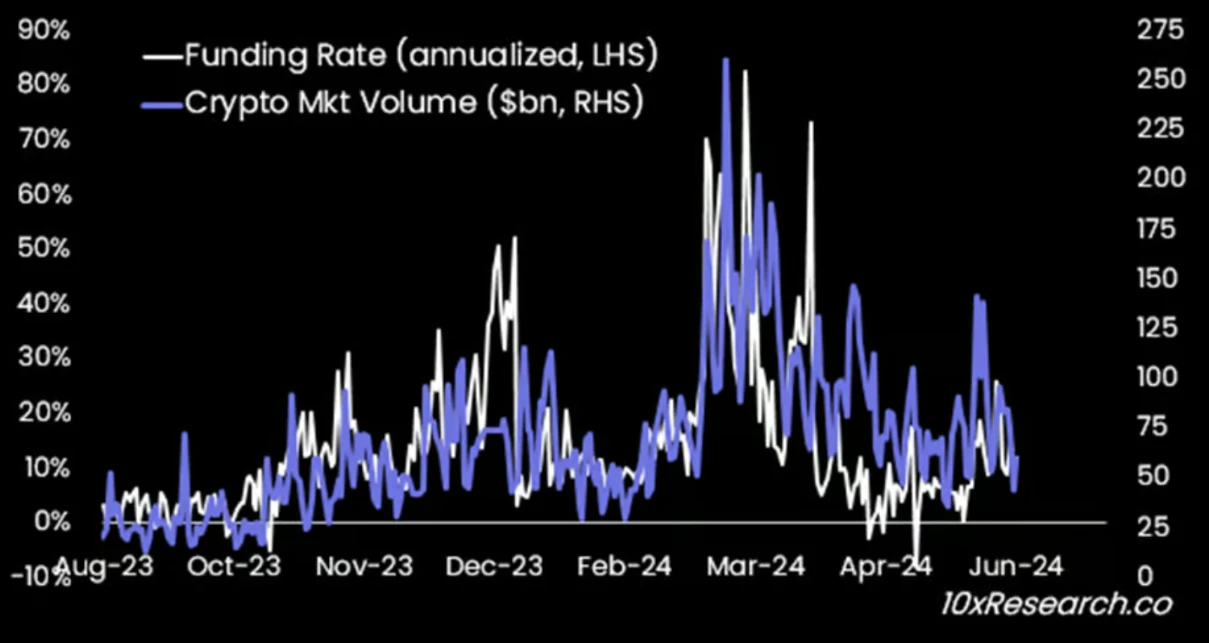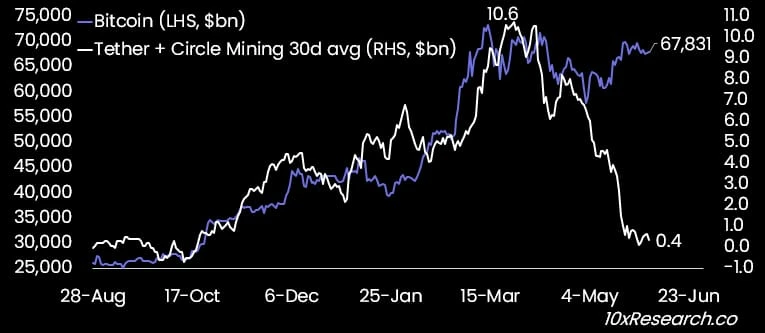This article comes from Bitcoin Stuck in This Range? Or a Breakout Looms?
Original author: Markus Thielen
Compiled by: Odaily Planet Daily Husband

Market Status and Key Variables
Despite the fact that Bitcoin is only 7% below its all-time high, traders are complaining that the price of Bitcoin is stagnant. Large amounts of Bitcoin are being moved out of exchanges, while stablecoin momentum is flashing warning signs. Crypto market volume has fallen to $50 billion, and funding rates are only slightly positive, indicating that trading interest is low.
Federal Reserve policy and inflation data are seen as two key variables driving Bitcoin to new all-time highs.
On June 5, the Bank of Canada may initiate a global rate cut cycle to provide reference for the Federal Reserve, and the US inflation data on June 12 needs to show a lower inflation rate of 3.3% for Bitcoin to rise.
The chart below shows Bitcoin funding rate (left axis, white) versus cryptocurrency trading volume (right axis, purple, in billions of dollars):

Bitcoin Transfer and Exchange Dynamics
The sharp drop in the balance of Bitcoin on exchanges suggests that large investors are moving Bitcoin out of exchanges to hoard it in anticipation of price increases .
In May this year, a total of 88,000 bitcoins were transferred out of exchanges, and currently there are 2.5 million bitcoins left, the lowest since March 2018. The outflow of bitcoins from exchanges began on May 15, coinciding with the 45 days after the quarter-end 13 F filing requirement for US registered investors managing more than $100 million.
Coinbase accounted for a third of these outflows (29,000), with seven of the top ten exchanges showing outflows, and only Bitfinex seeing strong inflows (7,600). At the end of May, 50,000 Bitcoins were moved out of exchanges. These data points are bullish, and the record high hashrate of 657m TH/s on May 27 (which subsequently fell slightly to 602m TH/s) suggests that some mining activity remains bullish.
Analysis of miners and large investors’ behavior
Starting from November 2023 (when Bitcoin was close to 40,000), the Bitcoin miner wallet balance gradually decreased from 1.835 million BTC to 1.806 million BTC until the Bitcoin halving on April 20, when the balance remained stable for several weeks.
However, the decline in balances has increased over the past two weeks as reduced block rewards force miners to sell inventory to cover operating costs. Bitcoin miner wallets currently hold 1.804 million BTC. And miners are continuing to sell Bitcoin.
In May, whales (holding >10,000 BTC) accumulated 164,000 BTC, the highest monthly accumulation since January 2018 (the peak of the third bull run). Whales (holding 1,000-10,000 BTC) sold 118,000 BTC, the most since December 2022 (near the low). Sharks (holding 100-1,000 BTC) sold heavily in February 2024 (165,000 BTC), but bought heavily in March 2024 (159,000 BTC). The accumulation of Bitcoin by whales and the movement of coins from exchanges are bullish.
Stablecoin issuance and market liquidity
To recap, the distribution of the 19.7 million circulating Bitcoins is between: 1.77 million possibly lost (a relatively stable number since 2013), whales (3.12 million BTC, the highest level since November 2022), whales (4.8 million), sharks (3.87 million), fish (10-100 BTC, 2.57 million), crabs (1-10 BTC, 2.13 million), and shrimps (<1 BTC, 1.42 million). This shows that Bitcoin holders with at least 100 BTC (sharks) dominate the market, but whales (at least 1k BTC) are the largest class of holders.
With nearly $140 billion worth of stablecoins in issue, more than 50% of them are held by wallets with more than $10 million, suggesting that large investors rather than retail traders are driving the stablecoin (or overall cryptocurrency) market. However, two days after the Bitcoin halving, when Runes transaction fees peaked, the stablecoin balance held by whales (holding > $10 million) dropped from $76 billion to $72 billion.
Wallet holdings have become more stable and less volatile. Therefore, the peak in whale stablecoin holdings on April 22, 2024 could be a key turning point, indicating that large investors are either converting their stablecoins to crypto or fiat. However, new fiat-to-crypto inflows have stopped, which is worrying because this has been a key driver of Bitcoins rally from $30,000 to $70,000.
The chart below shows Bitcoin (left axis, purple) versus 30-day stablecoin impulse (right axis, white, in billions of dollars):

Just $400 million in net stablecoin issuance was disclosed in the past 30 days, which is concerning as the more positive stablecoin supply momentum has disappeared since Grayscale won its lawsuit against the SEC in September 2023.
Smaller wallets (holding less than $1 million) are still increasing their stablecoin holdings, either through new fiat-to-crypto conversions or, more likely, converting crypto holdings into stablecoins (to take profits or stop losses).
in conclusion
In summary, while smaller wallets are still increasing their stablecoin holdings, whales are quietly becoming less active and converting their stablecoins to cryptocurrencies (such as BTC) or fiat (liquidation). Whales buying Bitcoin coincided with the massive stablecoin minting in April/May. Minting has now been paused and Bitcoin is being moved out of exchanges.
This makes macroeconomic momentum the key variable. The market either needs a Fed rate cut (unlikely, but the June 5 Bank of Canada meeting could provide an early signal) or a lower inflation reading on June 12 (we think 3.3% is likely) that would cause the Fed members to at least turn dovish. Otherwise, Bitcoin could be stuck in the $60,000 to $73,000 range.










